AMD Zen 3 Ryzen Deep Dive Review: 5950X, 5900X, 5800X and 5600X Tested
by Dr. Ian Cutress on November 5, 2020 9:01 AM ESTCPU Tests: Simulation
Simulation and Science have a lot of overlap in the benchmarking world, however for this distinction we’re separating into two segments mostly based on the utility of the resulting data. The benchmarks that fall under Science have a distinct use for the data they output – in our Simulation section, these act more like synthetics but at some level are still trying to simulate a given environment.
DigiCortex v1.35: link
DigiCortex is a pet project for the visualization of neuron and synapse activity in the brain. The software comes with a variety of benchmark modes, and we take the small benchmark which runs a 32k neuron/1.8B synapse simulation, similar to a small slug.
The results on the output are given as a fraction of whether the system can simulate in real-time, so anything above a value of one is suitable for real-time work. The benchmark offers a 'no firing synapse' mode, which in essence detects DRAM and bus speed, however we take the firing mode which adds CPU work with every firing.
The software originally shipped with a benchmark that recorded the first few cycles and output a result. So while fast multi-threaded processors this made the benchmark last less than a few seconds, slow dual-core processors could be running for almost an hour. There is also the issue of DigiCortex starting with a base neuron/synapse map in ‘off mode’, giving a high result in the first few cycles as none of the nodes are currently active. We found that the performance settles down into a steady state after a while (when the model is actively in use), so we asked the author to allow for a ‘warm-up’ phase and for the benchmark to be the average over a second sample time.
For our test, we give the benchmark 20000 cycles to warm up and then take the data over the next 10000 cycles seconds for the test – on a modern processor this takes 30 seconds and 150 seconds respectively. This is then repeated a minimum of 10 times, with the first three results rejected. Results are shown as a multiple of real-time calculation.
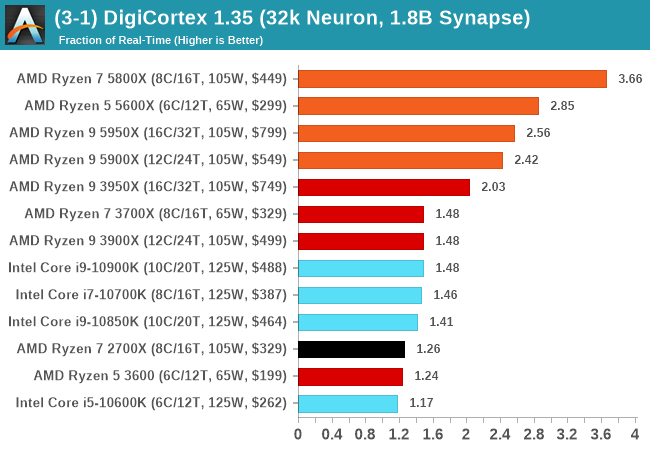
Dwarf Fortress 0.44.12: Link
Another long standing request for our benchmark suite has been Dwarf Fortress, a popular management/roguelike indie video game, first launched in 2006 and still being regularly updated today, aiming for a Steam launch sometime in the future.
Emulating the ASCII interfaces of old, this title is a rather complex beast, which can generate environments subject to millennia of rule, famous faces, peasants, and key historical figures and events. The further you get into the game, depending on the size of the world, the slower it becomes as it has to simulate more famous people, more world events, and the natural way that humanoid creatures take over an environment. Like some kind of virus.
For our test we’re using DFMark. DFMark is a benchmark built by vorsgren on the Bay12Forums that gives two different modes built on DFHack: world generation and embark. These tests can be configured, but range anywhere from 3 minutes to several hours. After analyzing the test, we ended up going for three different world generation sizes:
- Small, a 65x65 world with 250 years, 10 civilizations and 4 megabeasts
- Medium, a 127x127 world with 550 years, 10 civilizations and 4 megabeasts
- Large, a 257x257 world with 550 years, 40 civilizations and 10 megabeasts
DFMark outputs the time to run any given test, so this is what we use for the output. We loop the small test for as many times possible in 10 minutes, the medium test for as many times in 30 minutes, and the large test for as many times in an hour.
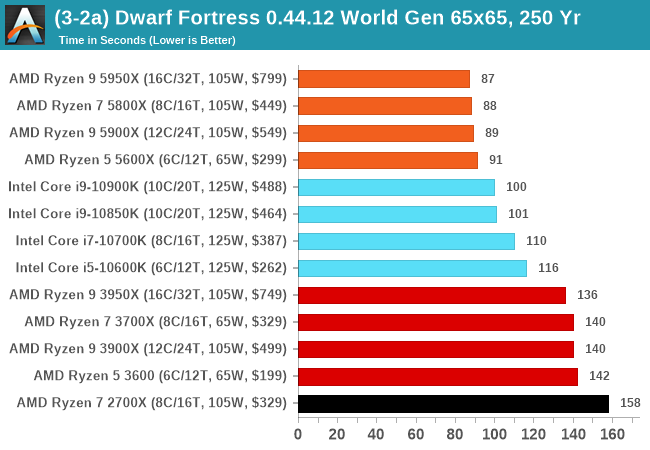
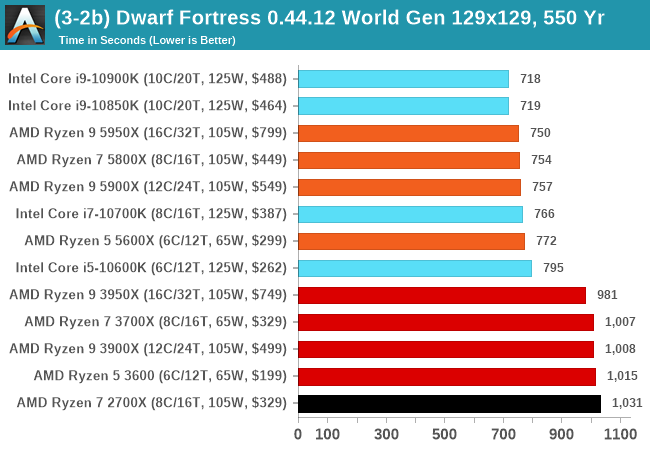
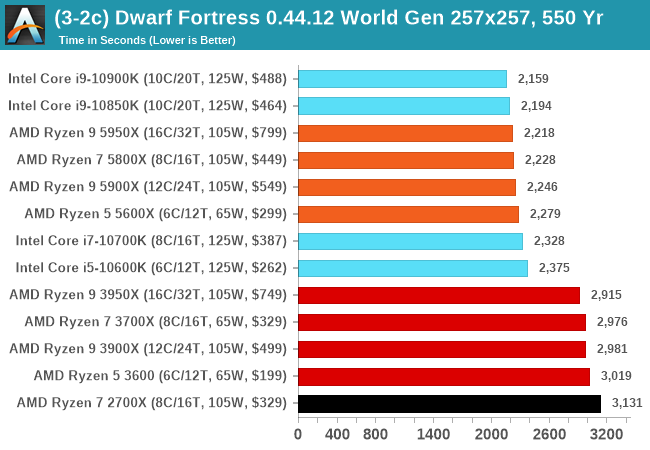
Dolphin v5.0 Emulation: Link
Many emulators are often bound by single thread CPU performance, and general reports tended to suggest that Haswell provided a significant boost to emulator performance. This benchmark runs a Wii program that ray traces a complex 3D scene inside the Dolphin Wii emulator. Performance on this benchmark is a good proxy of the speed of Dolphin CPU emulation, which is an intensive single core task using most aspects of a CPU. Results are given in seconds, where the Wii itself scores 1051 seconds.
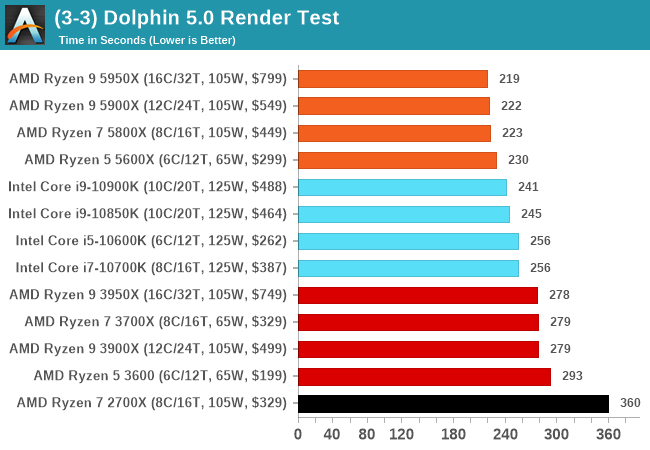












339 Comments
View All Comments
halcyon - Tuesday, November 10, 2020 - link
1. Ryzen 9 5xxx series dominate most gaming benhmarks in CPU bound games up to 720p2. However at 1440P/4K Intel, esp. 10850K pull ahead.
Can somebody explain this anomaly? As Games become more GPU bound at higher res, why does Intel pull ahead (with worse single/multi-thread CPU perf)? Is it a bandwidth/latency issue? If so, where exactly (RAM? L3? somewhere else)? Can't be PCIe, can it?
feka1ity - Saturday, November 14, 2020 - link
RAM. anandtech uses shitty ram for intel systemsMakste - Monday, November 16, 2020 - link
I think the game optimizations for intel processors become clear at those resolutions. AMD has been a none factor in gaming for so long. These games have been developed on and mostly optimised to work better on intel machinesSilma - Wednesday, November 11, 2020 - link
At 4K, the 3700X beats the 5600X quite often.Samus - Friday, November 13, 2020 - link
Considering Intel just released a new generation of CPU's, it's astonishing at their current IPC generation-over-generation trajectory, it will take them two more generations to surpass Zen 3. That's almost 2 years.Wow.
ssshenoy - Tuesday, December 15, 2020 - link
I dont think this article compares the latest generation from Intel - the Willow Cove core in Tiger lake which is launched only for notebooks. The comparison here seems to be with the ancient Skylake generation on 14 nm.abufrejoval - Friday, November 13, 2020 - link
Got my Ryzen 7 5800X on a new Aorus X570 mainboard and finally working, too.It turbos to 4850MHz without any overclocking, so I'd hazard 150MHz "bonus" are pretty much the default across the line.
At the wall plug 210 Watts was the biggest load I observed for pure CPU loads. HWinfo never reporting anything in excess of 120 Watts on the CPU from internal sensors.
"finally working": I want ECC with this rig, because I am aiming for 64GB or even 128GB RAM and 24x7 operation. Ordered DDR4-3200 ECC modules from Kingston to go with the board. Those seem a little slow coming so I tried to make do with pilfering some DIMMs from other systems, that could be shut down for a moment. DDR4-2133 ECC and DDR4-2400 ECC modules where candidates, but wouldn't boot...
Both were 2Rx4, dual rank, nibble not byte organized modules, unbuffered and unregistered but not the byte organized DIMMs that the Gigabyte documentation seeemd to prescribe... Asus, MSI and ASrock don't list such constraints, but I had to go with availability...
I like to think of RAM as RAM, it may be slower or faster, but it shouldn't be tied to one specific system, right?
So while I await the DDR4-3200 ECC 32GB modules to arrive, I got myself some DDR4-4000 R1x8 (no ECC, 8GB) DIMMs to fill the gap: But would that X570 mainboard, which might have been laying on shelves for months actually boot a Ryzen 5000?
No, it wouldn't.
But yes, it would update the BIOS via Q-Flash Plus-what-shall-we-call-it and then, yes, it did indeed recognize both the CPU and those R1x8 DIMMs just fine after the update.
I haven't yet tried those R2x4 modules again, because I am still exploring the bandwidth high-end, but I want to report just how much I am impressed by the compatibility of the AM4 platform, fully aware that Zen 3 will be the last generation in this "sprint".
I vividly remember how I had to get Skylake CPUs in order to get various mainboard ready for Kaby Lake...
I have been using AMD x86 CPUs from 80486DX4. I owned every iteration of K6-II and K6-III, omitted all Slot-A variants, got back with socket-A, 754, 939, went single, quad, and hexa (Phenom II x4+x6), omitted Bulldozer, but did almost every APU but between Kaveri and Zen 3, AMD simply wasn't compelling enough.
I would have gotten a Ryzen 9 5950x, if it had been available. But I count myself lucky for the moment to have snatched a Ryzen 7 5800X: It sure doesn't disappoint.
AMD a toast! You have done very well indeed and you can count me impressed!
Of course I'll nag about missing SVE/MKTME support day after tomorrow, but in the mean-time, please accept my gratitude.
feka1ity - Saturday, November 14, 2020 - link
Interesting, my default 9700k with 1080ti does 225fps avg - Borderlands 3, 360p, very low settings and anantech testers poop 175fps avg with 10900k and 2080ti?!? And this favoritize amede products. Fake stuff, sorry.Spunjji - Monday, November 16, 2020 - link
"Fake stuff"Thanks for labelling your post
feka1ity - Monday, November 16, 2020 - link
Fake stuff is not a label, it's a epicrisis. Go render stuff, spunji